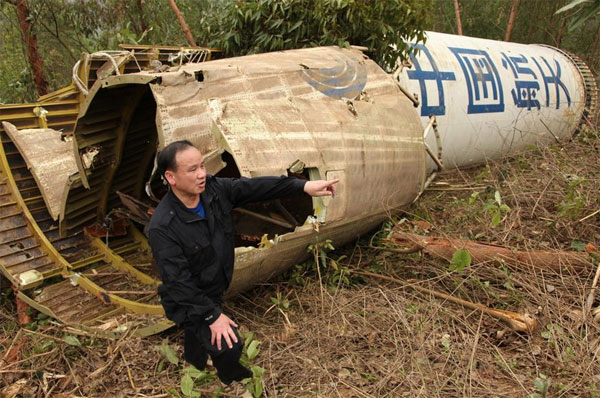Why don't more people get hit by falling space debris?
為什么被墜落的太空碎片擊中的人并沒有想象的那么多?
THE GOOD NEWS IS THAT YOU DIDN'T GET clobbered by China's Tiangong-1 space station when it fell to Earth on April 1.
好消息是,4月1日中國的天宮一號空間站墜落地球時沒有砸到你。
The not-so-good news is that there's a lot more space junk where that came from.
不太好的消息是,像天宮一號那樣的太空垃圾還有很多。
All the same, you can take off your hard hat, because your odds of getting conked are vanishingly small.
盡管如此,你還是可以摘下你的安全帽,因為你被擊中的幾率微乎其微。
At any moment, there are more than 500,000 pieces of space debris orbiting Earth.
任何時候,都有超過50萬個太空碎片在繞地球運行。
Some are no bigger than a millimeter or two;
有些不超過一兩毫米;
others—like Tiangong-1, which was the size of a school bus—are a potential menace.
其他的,比如校車大小的天宮一號,則有著潛在的威脅。
Left to themselves, the majority of satellites eventually tumble out of orbit.
如果任其發展,大多數衛星最終都會脫離軌道。
The principal cause is drag from the faint wisps of atmosphere that reach into what we consider the vacuum of space.
主要的原因是滲入我們所謂的“真空”的太空的幾縷空氣對那些物體的拉力。
The lower a spacecraft orbits, the more it feels these atmospheric fingers
航天器軌道越低,就越能感覺到這些“大氣之手”的拉力,
and the less far it has to fall in the first place before beginning its final, laming dive.
在開始最后一段晃晃悠悠的俯沖之前,它最初要墜落的距離就越短。
Making things worse, the atmosphere subtly expands and contracts in response to solar activity.
更糟糕的是,大氣層會隨著太陽活動進行微妙的膨脹和收縮。
The drag it exerts on any orbiting spacecraft can thus unpredictably increase or decrease,
它對任何軌道航天器施加的阻力就會因此增大或縮小,但具體并不能預測,
making it hard for NASA or other agencies to predict precisely where the spacecraft will land.
這就使得NASA或其他機構難以準確地預測航天器的降落位置。
Worse, derelict spacecraft often tumble,
更加糟糕的是,廢棄的航天器經常翻轉,
causing the face— and thus the surface area—they present to the atmosphere
因而它們面向大氣層的表面,以及相應的整個表面區域
to change constantly, adding one more X factor to the trajectory equation.
會頻繁地改變,這樣就又給軌道方程增加了一個未知因子。

One of the reasons none of this typically presents a danger is that when satellites reach the end of their useful lives,
但這些因素通常并不會帶來危險,原因之一在于衛星的有效壽命接近尾聲時,
they can be deorbited in a controlled way, sent on suicide dives to the middle of the ocean.
人們可以控制它們脫離軌道的方式,將它們以自殺式飛撲的方式送入茫茫大海。
It's when something goes wrong—when communications are lost or thruster fuel is exhausted—that re-entry becomes a crapshoot.
出現問題————通訊中斷或推進器燃料耗盡——的時候,重返大氣層能不能成功就要看運氣了。
That's what happened when NASA's Skylab space station tumbled to Earth in 1979, and it's what happened with Tiangong-1 too.
1979年,NASA的“太空實驗室”空間站墜落和這次“天宮一號”的墜落就是例子。
Even in those situations, the odds are very much on safety's side.
但即使在這樣的情況下,安全墜落的可能性也還是更大。
Roughly 70% of Earth's surface is water, and much of its landmass is unpopulated.
因為大約70%的地球表面都是水,而即便是陸地,也還是有很多地方是無人居住的。
Some of Skylab's debris did rain down on land, but in a sparsely populated desert.
所以,盡管“太空實驗室”是有一些碎片降落在了陸地上,但還是落在了人煙稀少的沙漠里。
The little town of Esperance, Australia, got some debris to exhibit in its local museum—
澳大利亞小鎮埃斯佩蘭斯在當地博物館展出了一些太空垃圾的殘骸,
along with a display of the $400 check it received in payment of a (mostly) playful highway-littering fine it imposed on the U.S.—but no one was injured.
還有一張小鎮收到的400美元的支票,那是他們以美方在他們的高速公路上亂扔垃圾,堪稱(最)調皮的扔垃圾了——好在沒人受傷——為由給美國開的罰單。
If you're still worried, take comfort in some numbers:
如果你還是擔心太空垃圾會砸到你,下面這些數字應該能讓你安心不少:
in the long history of spaceflight, only one person has ever gotten on the wrong side of a piece of falling space junk.
在漫長的航天歷史中,只有一個人在太空垃圾墜落的時候站在了錯誤的一邊。
That was Lottie Williams of Tulsa, Okla., who was struck on the shoulder by a piece of a Delta II rocket in 1997.
這個人就是俄克拉荷馬州塔爾薩的洛特·威廉姆斯。1997年,一枚德爾塔II型火箭的碎片擊中了她的肩膀。
She was unhurt.
但她還是沒有受傷。
According to the Aerospace Corp., a nonprofit group that tracked Tiangong-1's fall,
據追蹤天宮一號下落的非營利組織“航空航天”公司稱,
the likelihood of an individual being hit by space debris is less than 1 in 1 trillion.
一個人被太空碎片擊中的可能性不到1萬億分之一。
The European Space Agency pegs the odds even longer.
歐洲航天局認為的可能性更小,
It says getting struck by lightning is 10 million times as likely as the 1-in-300 trillion odds of being hit by space debris.
聲稱被閃電擊中的可能性是被太空碎片擊中的1/300萬億的幾率的1000萬倍。
譯文由可可原創,僅供學習交流使用,未經許可請勿轉載。



